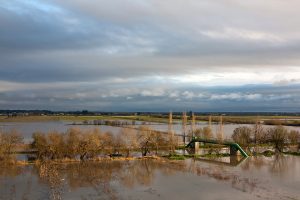
Bentley University, Waltham, USA
Keywords: dam failure, dam collapse, disaster, Mekong, infrastructure, development finance
DOI: 10.5509/2024972-art7
In the dark of a July night in 2018, a 5-billion-cubic-metre torrent of muddy water crashed through rooftops and ripped through the downstream villages of southeast Lao People’s Democratic Republic (Lao PDR). An auxiliary “saddle” dam had collapsed in the US$1.02 billion Xe Pian-Xe Namnoy (XPXN) Hydropower Project that was still under construction and had just reached financial contractual close five years prior, in 2013. In the aftermath of the collapse, official state narratives pointed to extreme weather conditions and “unforeseen” construction and engineering miscalculations, viewing soil conditions as the primary culprit. This paper examines the financial dimensions of dam failure and introduces the term “fast finance”: financier-driven timelines that have drastically expedited and shortened the legal, social, and pre-construction processes involved in hydropower dam projects to the detriment of dam safety, due diligence, and local participatory input. Extreme weather and anthropogenic climate change are not sole explanatory factors in the XPXN dam disaster. This paper highlights the also significant role of financial and political interests as contributing factors in dam safety and failure alongside extreme weather. The paper challenges conventional “natural disaster” framing of dam collapse by bringing into focus ex-ante political decision-making, financial engineering, and construction planning prior to dam construction to highlight the ways in which the XPXN catastrophe also had anthropogenic and “unnatural” contributing factors. Fast finance encompasses the role of temporality and the responsibility of state-business actors in ex-ante financial and infrastructure decisions that conclude with catastrophic outcomes. The article examines the re-engineering of contemporary dam finance through a case study of Lao PDR and argues that issues of financial engineering should be examined alongside other forms of civil, mechanical, structural, and hydrological engineering in the analysis of dam disasters. The temporal logics of financial actors—particularly the financialized logic of fast finance—has displaced the public-good-producing logic of patient capital. Financial logics shape and condition other forms of engineering and construction and are central to considerations of dam safety and accountability. Naturalizing discourses around extreme weather and aging dams deflect from the financial decisions and policy action, or inaction, of state-business actors to prevent dam collapse.
非自然灾害:“快速金融”与老挝人民民主共和国大坝灾难性溃坝的政治经济学:以桑片–桑南内为案例
关键词:大坝失败、大坝垮塌、灾难、湄公河、基础设施、开发金融
2018年7月的一个暗夜,一股50亿立方米的泥水洪流一路冲破屋顶,席卷老挝人民民主共和国(Lao PDR)东南部下游的村庄。耗资10.2亿美金、仍在建设中,并且于五年前的2013年刚刚完成融资合约签订的的桑片-桑南内(Xe Pian-Xe Namnoy,XPXN)水力发电项目的一个辅助性的“马鞍”坝溃坝了。溃坝事件后,官方说法指向了极端天气状况以及“不可预见的”建筑和工程计算失误,将土壤条件视为罪魁祸首。本论文考察了大坝失败的金融维度,引入了“快速金融”的概念:金融家驱动的时间线急剧加速并缩短了水电大坝工程涉及的法律、社会和开工前流程,危害到了大坝安全、尽职调查以及当地参与性意见的征求。极端天气和人为的气候变化并非是XPXN溃坝灾害的唯一解释变量。本论文强调了除极端天气以外,金融和政治利益作为影响大坝安全和失败的重要因素的显著作用。本文挑战了大坝崩塌的常规性的“自然灾害”框架,聚焦于在大坝的事前政治决策、金融工程学以及开工前的建设规划, 突出了XPXN灾难也具有人为和“非自然”的因素作用的各种方式。“快速金融”涵盖了暂时性的作用和政府和企业行动者在导致灾难性后果的事前金融和基础性设施决策中的责任。本文通过对老挝人民民主共和国的一个案例分析,考察了当代建坝金融的重构,提出在大坝灾难分析中,金融工程问题应当跟其它形式的民用、机械、结构和水利工程问题一起加以考察。金融行动者的时间逻辑——特别是“快速金融”的金融化逻辑——已经取代了耐心的资本的公共物品制造的逻辑。金融逻辑塑造和制约了其它形式的工程和建造,对于大坝安全和可问责性的考量来说至关重要。围绕极端天气和大坝老化的自然化话语体系转移了对政府和企业行动者为避免大坝垮塌所作的金融决定以及是否采取政策行动的注意力.
Translated by Li Guo